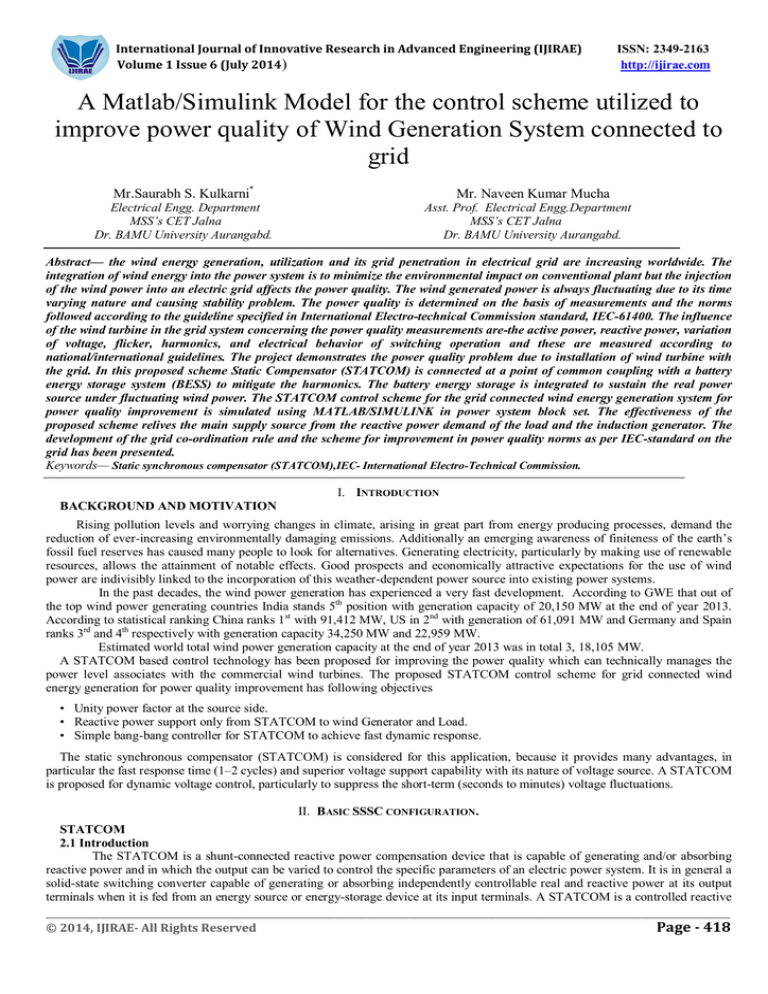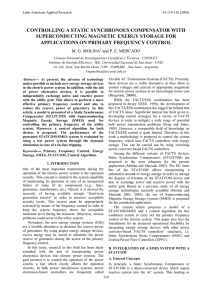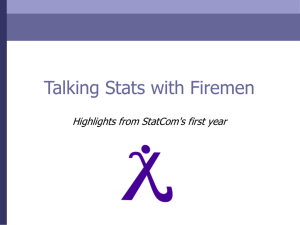
International Journal of Innovative Research in Advanced Engineering (IJIRAE)
Volume 1 Issue 6 (July 2014)
ISSN: 2349-2163
http://ijirae.com
A Matlab/Simulink Model for the control scheme utilized to
improve power quality of Wind Generation System connected to
grid
Mr.Saurabh S. Kulkarni*
Electrical Engg. Department
MSS’s CET Jalna
Dr. BAMU University Aurangabd.
Mr. Naveen Kumar Mucha
Asst. Prof. Electrical Engg.Department
MSS’s CET Jalna
Dr. BAMU University Aurangabd.
Abstract— the wind energy generation, utilization and its grid penetration in electrical grid are increasing worldwide. The
integration of wind energy into the power system is to minimize the environmental impact on conventional plant but the injection
of the wind power into an electric grid affects the power quality. The wind generated power is always fluctuating due to its time
varying nature and causing stability problem. The power quality is determined on the basis of measurements and the norms
followed according to the guideline specified in International Electro-technical Commission standard, IEC-61400. The influence
of the wind turbine in the grid system concerning the power quality measurements are-the active power, reactive power, variation
of voltage, flicker, harmonics, and electrical behavior of switching operation and these are measured according to
national/international guidelines. The project demonstrates the power quality problem due to installation of wind turbine with
the grid. In this proposed scheme Static Compensator (STATCOM) is connected at a point of common coupling with a battery
energy storage system (BESS) to mitigate the harmonics. The battery energy storage is integrated to sustain the real power
source under fluctuating wind power. The STATCOM control scheme for the grid connected wind energy generation system for
power quality improvement is simulated using MATLAB/SIMULINK in power system block set. The effectiveness of the
proposed scheme relives the main supply source from the reactive power demand of the load and the induction generator. The
development of the grid co-ordination rule and the scheme for improvement in power quality norms as per IEC-standard on the
grid has been presented.
Keywords— Static synchronous compensator (STATCOM),IEC- International Electro-Technical Commission.
I. INTRODUCTION
BACKGROUND AND MOTIVATION
Rising pollution levels and worrying changes in climate, arising in great part from energy producing processes, demand the
reduction of ever-increasing environmentally damaging emissions. Additionally an emerging awareness of finiteness of the earth’s
fossil fuel reserves has caused many people to look for alternatives. Generating electricity, particularly by making use of renewable
resources, allows the attainment of notable effects. Good prospects and economically attractive expectations for the use of wind
power are indivisibly linked to the incorporation of this weather-dependent power source into existing power systems.
In the past decades, the wind power generation has experienced a very fast development. According to GWE that out of
the top wind power generating countries India stands 5th position with generation capacity of 20,150 MW at the end of year 2013.
According to statistical ranking China ranks 1st with 91,412 MW, US in 2nd with generation of 61,091 MW and Germany and Spain
ranks 3rd and 4th respectively with generation capacity 34,250 MW and 22,959 MW.
Estimated world total wind power generation capacity at the end of year 2013 was in total 3, 18,105 MW.
A STATCOM based control technology has been proposed for improving the power quality which can technically manages the
power level associates with the commercial wind turbines. The proposed STATCOM control scheme for grid connected wind
energy generation for power quality improvement has following objectives
• Unity power factor at the source side.
• Reactive power support only from STATCOM to wind Generator and Load.
• Simple bang-bang controller for STATCOM to achieve fast dynamic response.
The static synchronous compensator (STATCOM) is considered for this application, because it provides many advantages, in
particular the fast response time (1–2 cycles) and superior voltage support capability with its nature of voltage source. A STATCOM
is proposed for dynamic voltage control, particularly to suppress the short-term (seconds to minutes) voltage fluctuations.
II. BASIC SSSC CONFIGURATION.
STATCOM
2.1 Introduction
The STATCOM is a shunt-connected reactive power compensation device that is capable of generating and/or absorbing
reactive power and in which the output can be varied to control the specific parameters of an electric power system. It is in general a
solid-state switching converter capable of generating or absorbing independently controllable real and reactive power at its output
terminals when it is fed from an energy source or energy-storage device at its input terminals. A STATCOM is a controlled reactive
__________________________________________________________________________________________________________
© 2014, IJIRAE- All Rights Reserved
Page - 418
International Journal of Innovative Research in Advanced Engineering (IJIRAE)
Volume 1 Issue 6 (July 2014)
ISSN: 2349-2163
http://ijirae.com
power source. It provides the desired reactive power generation and absorption entirely by means of electronic processing of the
voltage and current waveforms in a voltage source to a utility bus through a magnetic coupling. A schematic diagram of a basic
STATCOM is shown in Fig.2.1.
Figure 2.1 Schematic Diagram of a Basic STATCOM
A STATCOM can improve power system performance as follows: The dynamic voltage control in transmission and
distribution systems. The power oscillation damping in power transmission systems. The transient stability, the voltage flicker
control, and the control of not only reactive power but also (if needed) active power in the connected line, requiring a dc energy
source.
2.1.1 PRINCIPLE OF OPERATION
The STATCOM consists of a voltage source converter connected in shunt with the system. For the distribution level
STATCOM pulse width modulation is typically used to reduce the harmonic output of the converter. Depending on the application,
the STATCOM may be operated to achieve the following objectives:
a. Voltage regulation at a particular ac bus
b. Rapid power factor correction of a particular load
c. Power factor correction and load balancing and/or harmonic compensation of a particular load.
Basically, the STATCOM system is comprised of three main parts: a VSC, a set of coupling reactors or a step-up
transformer, and a controller. In a very-high-voltage system, the leakage inductances of the step-up power transformers can function
as coupling reactors. The main purpose of the coupling inductors is to filter out the current harmonic components that are
generated mainly by the pulsating output voltage of the power converters. The STATCOM is connected to the power
networks at a PCC, where the voltage-quality problem is a concern. All required voltages and currents are measured and are fed
into the controller to be compared with the commands. The controller then performs feedback control and outputs a set of
switching signals to drive the main semiconductor switches of the power converter accordingly. In general, the VSC is represented
by an ideal voltage source associated with internal loss connected to the AC power via coupling reactors.
A STATCOM can provide fast capacitive and inductive compensation and is able to control its output current
independently of the AC system voltage. There are mainly two approaches to mitigate power quality problem. The first approach is
load conditioning, which ensures that equipment is made less sensitive to power disturbances, allowing the operation even under
significant voltage distortion. The other solution is to install line conditioning system that suppresses the power disturbances.
__________________________________________________________________________________________________________
© 2014, IJIRAE- All Rights Reserved
Page -419
International Journal of Innovative Research in Advanced Engineering (IJIRAE)
Volume 1 Issue 6 (July 2014)
ISSN: 2349-2163
http://ijirae.com
Control Scheme
The control scheme approach is based on injecting the currents into the grid using “bang-bang controller.” The controller uses a
hysteresis current controlled technique. Using such technique, the controller keeps the control system variable between boundaries
of hysteresis area and gives correct switching signals for STATCOM operation.
The control system scheme for generating the switching signals to the STATCOM is shown in Fig. 3. The control
algorithm needs the measurements of several variables such as three-phase source current iSabc, DC voltage Vdc, inverter current iiabc
with the help of sensor. The current control block, receives an input of reference current i*Sabc and actual current iSabc are subtracted
so as to activate the operation of STATCOM in current control mode [16]–[18].
4.7 Grid Synchronization
The control of power flow between a grid-connected power converter and the ac mains requires an online tracking of the
fundamental component voltage (or current) phase angle. Due to this switching function, the inverter injects the current into the grid
in such a way that the source current is harmonic free. The injected current will cancel out the reactive and harmonic part of the load
current and thus improve the power factor. To accomplish these goals, the grid voltages are sensed and synchronized in generating
the current command for the inverter.
In three-phase balance system, the RMS voltage source amplitude is calculated at the sampling frequency from the source
phase voltage (Vsa, Vsb, Vsc) and is expressed, as sample template Vsm, sampled peak voltage, as in (9).
V
=
(V
+V
+V
)
/
(8)
The in-phase unit vectors are obtained from AC source phase voltage and the RMS value of unit vector (Usa,Usb,Usc) as shown in
(10).
u
=
V
,u
V
=
V
V
,u =
(9)
V
V
The in-phase generated reference currents are derived using in-phase unit voltage template as, in (10)
i∗ = I. u ,i∗ = I. u ,i∗ = I. u (10)
Where, I is proportional to magnitude of filtered source voltage for respective phases. This ensures that the source current
is controlled to be sinusoidal. The unit vectors implement the important function in the grid connection for the synchronization for
STATCOM. This method is simple, robust and favorable as compared with other methods [18]. Here unit vectors can be obtained
by using Phased Locked Loop (PLL) block in the power system block set. This gives the frequency, angle and sin-cos function of
angle. By multiplying angle with sin function we will get unit vector according to the phase ‘a’. In order to get the unit vectors of
other phases the angle is delayed by -1200, -2400 again multiplied by sin function. After the getting the gain of PI controller it is
directly multiplied by these unit vectors which gives the reference current , it is used to compare with actual currents in the
Hysteresis Current Controller(HCC).
__________________________________________________________________________________________________________
© 2014, IJIRAE- All Rights Reserved
Page -420
International Journal of Innovative Research in Advanced Engineering (IJIRAE)
Volume 1 Issue 6 (July 2014)
ISSN: 2349-2163
http://ijirae.com
V. SIMULATION RESULTS IN MATLAB SIMULINK
The proposed control scheme is simulated using SIMULINK in power system block set. The system
parameter for given system is given Table 5.1.
Table 5.1 System Parameters
S.NO
Parameters
Ratings
1.
Grid voltage
3-phase,415V,50Hz
2.
Induction Generator
3.35 KVA,415V,50Hz,P=4,
Rs=0.01Ω, Rr=0.015 Ω, Ls=0.06H,Lr=0.06H.
5.1
3.
Inverter Parameters
4.
IGBT rating
5.
Load Parameter
DC link Voltage=800V
DC link Capacitance=100µF
Switching frequency =2kHz
Collector Voltage =1200V, Forward Current =50A,
Gate voltage=20V
Power dissipation =310W
Non-Linear Load 25kW,50kVAR
Simulink Model of Grid Connected Wind Energy System Using STATCOM
Results obtained without using STATCOM up to 0.7s:
__________________________________________________________________________________________________________
© 2014, IJIRAE- All Rights Reserved
Page -421
International Journal of Innovative Research in Advanced Engineering (IJIRAE)
Volume 1 Issue 6 (July 2014)
ISSN: 2349-2163
http://ijirae.com
III. Below are the results shown of the system without using STATCOM up to 0.7 s. Source current, load current, inverter injected
current and induction generator current are shown in figure 5.2(a), 5.2(b), 5.3(c), and 5.3(d) respectively..
IV. Fig. 5.2(a) Source Current. (b) Load Current. (c) Inverter Injected Current.
(d) Wind generator (Induction generator) current, without STATCOM
Results obtained using STATCOM after 0.7s:
Below are the results shown of the system using STATCOM after 0.7 s. Source current, load current, inverter injected current and
induction generator current are shown in figure 5.3(a), 5.3(b), 5.3(c), and 5.3(d) respectively.
Supply Voltage and Current at PCC
__________________________________________________________________________________________________________
© 2014, IJIRAE- All Rights Reserved
Page -422
International Journal of Innovative Research in Advanced Engineering (IJIRAE)
Volume 1 Issue 6 (July 2014)
ISSN: 2349-2163
http://ijirae.com
V. CONCLUSION
This report presents the control scheme for power quality improvement in grid connected wind generating system with
non linear load. The power quality issues and its consequences on the consumer and electric utility are presented.
STATCOM based SIMULINK MODEL for grid connected wind energy system is also proposed. It has the capability to
cancel out the harmonic parts of the load current.. It maintains the source voltage and current in phase and supports
the reactive power demand for the wind generator and load at PCC in the grid system, thus it gives an opportunity to
enhance the utilization factor of the transmission line. The integrated wind generation and STATCOM have the
outstanding performance. In addition, since the STATCOM suppresses the voltage fluctuation, it is apparent that,
compared to the case without STATCOM.
REFERENCES
Base paper:
Sharad W. Mohod ,Mohan V. Aware “A STATCOM-Control Scheme for Grid Connected Wind Energy System for Power
Quality Improvement” IEEE systems journal,vol.4,no.3,september-2010.
[1] A. Sannino, “Global power systems for sustainable development,” in IEEE General Meeting, Denver, CO, Jun. 2004.
[2] K. S. Hook, Y. Liu, and S. Atcitty, “Mitigation of the wind generation integration related power quality issues by energy
storage,” EPQU J., vol. XII, no. 2, 2006.
[3] R. Billinton and Y. Gao, “Energy conversion system models for adequacy assessment of generating systems incorporating
wind energy,” IEEE Trans. on E. Conv., vol. 23, no. 1, pp. 163–169, 2008, Multistate.
[4] Wind Turbine Generating System—Part 21, International standard-IEC 61400-21, 2001.
[5] J. Manel, “Power electronic system for grid integration of renewable energy source: A survey,” IEEE Trans. Ind.
Electron., vol. 53, no. 4, pp. 1002–1014, 2006, Carrasco.
[6]
M. Tsili and S. Papathanassiou, “A review of grid code technology requirements for wind turbine,” Proc. IET
Renew.power gen., vol. 3, pp. 308–332, 2009.
[7] S. Heier, Grid Integration of Wind Energy Conversions. Hoboken, NJ: Wiley, 2007, pp. 256–259.
[8] J. J. Gutierrez, J. Ruiz, L. Leturiondo, and A. Lazkano, “Flicker measurement system for wind turbine certification,”
IEEE Trans. Instrum. Meas., vol. 58, no. 2, pp. 375–382, Feb. 2009.
[9] Indian Wind Grid Code Draft report on, Jul. 2009, pp. 15–18, C-NET.
[10] C. Han, A. Q. Huang, M. Baran, S. Bhattacharya, and W. Litzenberger, “STATCOM impact study on the integration of a
large wind farm into a weak loop power system,” IEEE Trans. Energy Conv., vol. 23, no. 1, pp. 226–232, Mar. 2008.
__________________________________________________________________________________________________________
© 2014, IJIRAE- All Rights Reserved
Page -423





